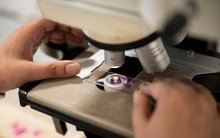‘The cost of staff shortages across histopathology departments is high for both patients and for our health services. For patients, it means worrying delays in diagnosis and treatment.
‘For NHS hospitals, it means spending more resources on locum doctors to fill staffing gaps, or outsourcing services. We estimate this costs £27m each year across the UK health service – money that could be better invested in staff and new diagnostic equipment.
‘Safe and effective high-quality patient care depends on having the right number of staff in the right places. Demand for pathology services has grown significantly in recent years and continues to grow. The pathology workforce has not increased in line with this demand. If this trend continues unchecked, clinical services could be in jeopardy. Making sure pathology services can cope with current and future demand is essential if we are to ensure early diagnosis and improve outcomes for patients.’
The report highlights the intense pressures that histopathologists face from increased workloads, such as new NHS screening programmes. In addition, services are facing more complex work as personalised medicine develops and guides new therapies. Outdated IT systems compound these pressures.
The census highlights:
An approaching retirement crisis – a quarter of all histopathologists are aged 55 or over.
Ensuring pathology services can cope with current and future demand is vital to improve outcomes for patients. The Royal College of Pathologists is proposing a range of solutions to address the shortage of histopathologists in the short and longer term, including:
- more funded training places, and ‘golden hellos’ for specialist histopathology trainees in hard-to-recruit areas
- better IT for day-to-day work
- capital investment to implement digital pathology more widely, so staff can work more efficiently and flexibly
- development of advanced clinical practitioners to work alongside medically-qualified histopathology colleagues.
Professor Jo Martin continued:
‘The College is actively raising concerns about the threats to service delivery due to workforce shortages – those that exist now and those that are expected in the future. We are making practical suggestions for solutions both in the short and longer term.
‘The additional funding announced for the NHS over the next five years is welcome. It is vital that part of that funding is invested in developing a sustainable pathology workforce that can meet the future needs of the NHS and the patients it cares for.’
Further information
- In 2017, the Royal College of Pathologists carried out a workforce census of histopathology departments in the UK. The resulting report, Meeting pathology demand – Histopathology workforce census, looks at the issues, recommends some actions that could help to alleviate the difficulties – both now and in the longer term – and includes comments and case studies from histopathologists working in different areas of the UK.
- Of the three-quarters of departments that responded, only 3% said they had enough staff to meet clinical demand. If these figures were extrapolated UK-wide, 137 of 158 departments wouldn’t have enough consultant histopathologists.
- For those departments where staffing was inadequate, different ways of coping were used – including employing locums, outsourcing or overtime.
- The introduction of the faecal immunochemical test (FIT) test for bowel cancer screening is expected to increase screening uptake. The College welcomes higher uptake in testing and the benefits for earlier diagnosis; however, it will increase pathology demand, both as a result of increased initial testing and because positive results lead to further testing.







